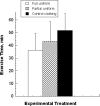The American football uniform: uncompensable heat stress and hyperthermic exhaustion
- PMID: 20210615
- PMCID: PMC2838463
- DOI: 10.4085/1062-6050-45.2.117
The American football uniform: uncompensable heat stress and hyperthermic exhaustion
Abstract
Context: In hot environments, the American football uniform predisposes athletes to exertional heat exhaustion or exercise-induced hyperthermia at the threshold for heat stroke (rectal temperature [T(re)] > 39 degrees C).
Objective: To evaluate the differential effects of 2 American football uniform configurations on exercise, thermal, cardiovascular, hematologic, and perceptual responses in a hot, humid environment.
Design: Randomized controlled trial.
Setting: Human Performance Laboratory.
Patients or other participants: Ten men with more than 3 years of competitive experience as football linemen (age = 23.8 +/- 4.3 years, height = 183.9 +/- 6.3 cm, mass = 117.41 +/- 12.59 kg, body fat = 30.1% +/- 5.5%).
Intervention(s): Participants completed 3 controlled exercise protocols consisting of repetitive box lifting (lifting, carrying, and depositing a 20.4-kg box at a rate of 10 lifts per minute for 10 minutes), seated recovery (10 minutes), and up to 60 minutes of treadmill walking. They wore one of the following: a partial uniform (PART) that included the National Football League (NFL) uniform without a helmet and shoulder pads; a full uniform (FULL) that included the full NFL uniform; or control clothing (CON) that included socks, sneakers, and shorts. Exercise, meals, and hydration status were controlled.
Main outcome measure(s): We assessed sweat rate, T(re), heart rate, blood pressure, treadmill exercise time, perceptual measurements, plasma volume, plasma lactate, plasma glucose, plasma osmolality, body mass, and fat mass.
Results: During 19 of 30 experiments, participants halted exercise as a result of volitional exhaustion. Mean sweat rate, T(re), heart rate, and treadmill exercise time during the CON condition were different from those measures during the PART (P range, .04-.001; d range, 0.42-0.92) and FULL (P range, .04-.003; d range, 1.04-1.17) conditions; no differences were detected for perceptual measurements, plasma volume, plasma lactate, plasma glucose, or plasma osmolality. Exhaustion occurred during the FULL and PART conditions at the same T(re) (39.2 degrees C). Systolic and diastolic blood pressures (n = 9) indicated that hypotension developed throughout exercise (all treatments). Compared with the PART condition, the FULL condition resulted in a faster rate of T(re) increase (P < .001, d = 0.79), decreased treadmill exercise time (P = .005, d = 0.48), and fewer completed exercise bouts. Interestingly, T(re) increase was correlated with lean body mass during the FULL condition (R(2) = 0.71, P = .005), and treadmill exercise time was correlated with total fat mass during the CON (R(2) = 0.90, P < .001) and PART (R(2) = 0.69, P = .005) conditions.
Conclusions: The FULL and PART conditions resulted in greater physiologic strain than the CON condition. These findings indicated that critical internal temperature and hypotension were concurrent with exhaustion during uncompensable (FULL) or nearly uncompensable (PART) heat stress and that anthropomorphic characteristics influenced heat storage and exercise time to exhaustion.
Figures





Similar articles
-
Perceptual responses while wearing an American football uniform in the heat.J Athl Train. 2010 Mar-Apr;45(2):107-16. doi: 10.4085/1062-6050-45.2.107. J Athl Train. 2010. PMID: 20210614 Free PMC article. Clinical Trial.
-
Necessity of Removing American Football Uniforms From Humans With Hyperthermia Before Cold-Water Immersion.J Athl Train. 2015 Dec;50(12):1240-6. doi: 10.4085/1062-6050-51.1.05. Epub 2015 Dec 17. J Athl Train. 2015. PMID: 26678288 Free PMC article.
-
Thermoregulatory and Perceptual Effects of a Percooling Garment Worn Underneath an American Football Uniform.J Strength Cond Res. 2017 Nov;31(11):2983-2991. doi: 10.1519/JSC.0000000000002207. J Strength Cond Res. 2017. PMID: 28858055 Clinical Trial.
-
Thermoregulation, Fluid Balance, and Sweat Losses in American Football Players.Sports Med. 2016 Oct;46(10):1391-405. doi: 10.1007/s40279-016-0527-8. Sports Med. 2016. PMID: 27071988 Review.
-
American College of Sports Medicine position stand. Exertional heat illness during training and competition.Med Sci Sports Exerc. 2007 Mar;39(3):556-72. doi: 10.1249/MSS.0b013e31802fa199. Med Sci Sports Exerc. 2007. PMID: 17473783 Review.
Cited by
-
The Impact of Different Environmental Conditions on Cognitive Function: A Focused Review.Front Physiol. 2016 Jan 6;6:372. doi: 10.3389/fphys.2015.00372. eCollection 2015. Front Physiol. 2016. PMID: 26779029 Free PMC article. Review.
-
Fluid Balance in Team Sport Athletes and the Effect of Hypohydration on Cognitive, Technical, and Physical Performance.Sports Med. 2017 Oct;47(10):1951-1982. doi: 10.1007/s40279-017-0738-7. Sports Med. 2017. PMID: 28508338 Free PMC article. Review.
-
Fatal Exertional Heat Stroke Trends in Secondary School Sports From 1982 Through 2022.Sports Health. 2024 Dec 11:19417381241298293. doi: 10.1177/19417381241298293. Online ahead of print. Sports Health. 2024. PMID: 39663688 Free PMC article.
-
Cooling Effectiveness of a Modified Cold-Water Immersion Method After Exercise-Induced Hyperthermia.J Athl Train. 2016 Nov;51(11):946-951. doi: 10.4085/1062-6050-51.12.07. Epub 2016 Nov 22. J Athl Train. 2016. PMID: 27874299 Free PMC article. Clinical Trial.
-
Risk perceptions for exertional heat illnesses in junior cricket in Sri Lanka.BMJ Open Sport Exerc Med. 2019 Mar 2;5(1):e000508. doi: 10.1136/bmjsem-2019-000508. eCollection 2019. BMJ Open Sport Exerc Med. 2019. PMID: 30899554 Free PMC article.
References
-
- Armstrong L. E., Casa D. J., et al. American College of Sports Medicine. American College of Sports Medicine position stand: exertional heat illness during training and competition. Med Sci Sports Exerc. 2007;39(3):556–572. - PubMed
-
- Department of the Army and Air Force. Heat Stress Control and Heat Casualty Management. Washington, DC: Dept of Defense; 2003. Publication TB MED507/AFPAM 48-152 (I). http://www.army.mil/usapa/med/DR_pubs/dr_a/pdf/tbmed507.pdf. Accessed September 1, 2009.
-
- Working in Hot Environments. Cincinnati, OH: National Institute for Occupational Safety and Health; 1986. Centers for Disease Control and Prevention, National Institute for Occupational Safety and Health. DHHS (NIOSH) publication 86-112. http://www.cdc.gov/niosh/hotenvt.html#sources. Accessed December 12, 2009.
-
- Armstrong L. E., Anderson J. M. Heat exhaustion, exercise-associated collapse, and heat syncope. In: Armstrong L. E., editor. Exertional Heat Illnesses. Champaign, IL: Human Kinetics; 2003. pp. 57–89.
-
- Yeargin S. W., Casa D. J., Armstrong L. E., et al. Heat acclimatization and hydration status of American football players during initial summer workouts. J Strength Cond Res. 2006;20(3):463–470. - PubMed

